A Compact Ultra-Wideband Monocone Antenna with Folded Shorting Wires for Vehicle-to-Everything (V2X) Applications
Abstract
1. Introduction
2. Antenna Design and Geometry
3. Results and Discussion
4. Antenna Fabrication and Measurements
5. V2X Field Test Results
6. Conclusions
Author Contributions
Funding
Institutional Review Board Statement
Informed Consent Statement
Acknowledgments
Conflicts of Interest
References
- Abboud, K.; Omar, H.A.; Zhuang, W. Interworking of DSRC and Cellular Network Technologies for V2X Communications: A Survey. IEEE Trans. Veh. Technol. 2016, 65, 9457–9470. [Google Scholar] [CrossRef]
- Bey, T.; Tewolde, G. Evaluation of DSRC and LTE for V2X. In Proceedings of the 2019 IEEE 9th Annual Computing and Communication Workshop and Conference CCWC, Las Vegas, NV, USA, 7–9 January 2019; pp. 1032–1035. [Google Scholar]
- Seeley, E.W. An experimental study of the disk-loaded folded monopole. IRE Trans. Antennas Propag. 1956, 4, 27–28. [Google Scholar] [CrossRef]
- Papas, C.; King, R. Input Impedance of Wide-Angle Conical Antennas Fed by a Coaxial Line. Proc. IRE 1949, 37, 1269–1271. [Google Scholar] [CrossRef]
- Schelkunoff, S. Theory of Antennas of Arbitrary Size and Shape. Proc. IRE 1941, 29, 493–521. [Google Scholar] [CrossRef]
- Liu, A.; Lu, Y. A Superwide Bandwidth Low-Profile Monocone Antenna With Dielectric Loading. IEEE Trans. Antennas Propag. 2019, 67, 4173–4177. [Google Scholar] [CrossRef]
- Palud, S.; Colombel, F.; Himdi, M.; Le Meins, C. A Novel Broadband Eighth-Wave Conical Antenna. IEEE Trans. Antennas Propag. 2008, 56, 2112–2116. [Google Scholar] [CrossRef]
- Shi, Y.; Amert, A.K.; Whites, K.W. Miniaturization of Ultrawideband Monocone Antennas Using Dielectric Loading. IEEE Trans. Antennas Propag. 2015, 64, 432–441. [Google Scholar] [CrossRef]
- Aten, D.W.; Haupt, R.L. A Wideband, Low Profile, Shorted Top Hat Monocone Antenna. IEEE Trans. Antennas Propag. 2012, 60, 4485–4491. [Google Scholar] [CrossRef]
- Zhou, S.-G.; Ma, J.; Deng, J.-Y.; Liu, Q.-Z. A low-profile and broadband conical antenna. Prog. Electromagn. Res. Lett. 2009, 7, 97–103. [Google Scholar] [CrossRef]
- Amert, A.K.; Whites, K.W. Miniaturization of the Biconical Antenna for Ultrawideband Applications. IEEE Trans. Antennas Propag. 2009, 57, 3728–3735. [Google Scholar] [CrossRef]
- Zhang, Z.-Y.; Fu, G.; Wu, W.-J.; Lei, J.; Gong, S.-X. A Wideband Dual-Sleeve Monopole Antenna for Indoor Base Station Application. IEEE Antennas Wirel. Propag. Lett. 2011, 10, 45–48. [Google Scholar] [CrossRef]
- Lee, M.W.; Seongheon Jeong, N. Low-Profile, Vehicle Roof-Top Mounted Broadband Antenna for V2X. In Proceedings of the 2019 IEEE International Symposium on Antennas and Propagation and USNC-URSI Radio Science Meeting, Atlanta, GA, USA, 7–12 July 2019; pp. 925–926. [Google Scholar] [CrossRef]
- Keum, K.; Choi, J.; Park, Y. A Wideband Top-Hat Loaded Monocone Antenna Using Shorting Strips. In Proceedings of the 2019 IEEE International Symposium on Antennas and Propagation and USNC-URSI Radio Science Meeting, Atlanta, GA, USA, 7–12 July 2019; pp. 263–264. [Google Scholar] [CrossRef]
- Keum, K.-S.; Park, Y.-M.; Choi, J.-H. A Low-Profile Wideband Monocone Antenna Using Bent Shorting Strips. Appl. Sci. 2019, 9, 1896. [Google Scholar] [CrossRef]
- Yang, D.; Hu, J.; Liu, S. A Low Profile UWB Antenna for WBAN Applications. IEEE Access 2018, 6, 25214–25219. [Google Scholar] [CrossRef]
- Zhang, H.; Zhang, F.-S.; Yang, Y.-L. An Electrically Small Low-Profile and Ultra-Wideband Antenna with Monopole-Like Radiation Characteristics. Prog. Electromagn. Res. Lett. 2017, 70, 99–106. [Google Scholar] [CrossRef]
- Nguyen-Trong, N.; Piotrowski, A.; Kaufmann, T.; Fumeaux, C. Low-Profile Wideband Monopolar UHF Antennas for Integration Onto Vehicles and Helmets. IEEE Trans. Antennas Propag. 2016, 64, 2562–2568. [Google Scholar] [CrossRef]
- Koohestani, M.; Zurcher, J.-F.; Moreira, A.A.; Skrivervik, A.K. A Novel, Low-Profile, Vertically-Polarized UWB Antenna for WBAN. IEEE Trans. Antennas Propag. 2014, 62, 1888–1894. [Google Scholar] [CrossRef]
- Keum, K.; Choi, J. An Ultra-Wideband 3-stage Monocone Antenna with Top-hat Loading. In Proceedings of the 2020 IEEE International Symposium on Antennas and Propagation and North American Radio Science Meeting, Montreal, QC, Canada, 5–10 July 2020; pp. 469–470. [Google Scholar] [CrossRef]
- Bai, X.; Su, M.; Gao, Z.; Liu, Y. An UWB Top-Loaded Monocone Antenna for Multiservice Wireless Applications. Prog. Electromagn. Res. Lett. 2018, 73, 91–97. [Google Scholar] [CrossRef]
- Akhoondzadeh-Asl, L.; Hill, J.; Laurin, J.-J.; Riel, M. Novel low profile wideband monopole antenna for avionics applications. IEEE Trans. Antennas Propag. 2013, 61, 5766–5770. [Google Scholar] [CrossRef]
- Nguyen-Trong, N.; Pinapati, S.P.; Hall, D.; Piotrowski, A.; Fumeaux, C. Ultralow-Profile and Flush-Mounted Monopolar Antennas Integrated Into a Metallic Cavity. IEEE Antennas Wirel. Propag. Lett. 2017, 17, 86–89. [Google Scholar] [CrossRef]
- Zhao, Y.; Shen, Z.; Wu, W. Wideband and Low-Profile Monocone Quasi-Yagi Antenna for Endfire Radiation. IEEE Antennas Wirel. Propag. Lett. 2016, 16, 325–328. [Google Scholar] [CrossRef]
- Bang, J. Wideband low-profile null-filled monopole antenna for aircraft flush-mount applications. Electron. Lett. 2015, 51, 1635–1637. [Google Scholar] [CrossRef]
- Lee, S.; Kim, S.; Park, Y.; Choi, J. A 3D-Printed Tapered Cavity-Backed Flush-Mountable Ultra-Wideband Antenna for UAV. IEEE Access 2019, 7, 156612–156619. [Google Scholar] [CrossRef]
- Tak, J.; Kang, D.-G.; Choi, J. A lightweight waveguide horn antenna made via 3D printing and conductive spray coating. Microw. Opt. Technol. Lett. 2017, 59, 727–729. [Google Scholar] [CrossRef]
- Lee, S.; Jeoung, G.; Choi, J. Three-dimensional-printed tapered cavity-backed flush-mountable wideband antenna for UAV. Microw. Opt. Technol. Lett. 2017, 59, 2975–2981. [Google Scholar] [CrossRef]
- Alkaraki, S.; Gao, Y.; Torrico, M.O.M.; Stremsdoerfer, S.; Gayets, E.; Parini, C. Performance Comparison of Simple and Low Cost Metallization Techniques for 3D Printed Antennas at 10 GHz and 30 GHz. IEEE Access 2018, 6, 64261–64269. [Google Scholar] [CrossRef]
- Le Sage, G.P. 3D Printed Waveguide Slot Array Antennas. IEEE Access 2016, 4, 1258–1265. [Google Scholar] [CrossRef]
- MK6C EVK. Cohda Wireless. n.d. Available online: https://www.cohdawireless.com/solutions/hardware/mk6c-evk/ (accessed on 1 September 2021).
- MXFG-5900. Available online: https://www.mobilemark.com/product/mxfg-5900 (accessed on 20 September 2022).
- MXF Series. Available online: https://www.mobilemark.com/product-category/gps-gnss-multiband-by-model/mxf-series/ (accessed on 8 February 2023).
- Chang, D.-C.; Cheng, P.-W.; Lee, C.-H.; Wu, C.-T.; Dau-Chyrh, C. Broadband wide-beam circular polarization antenna for global navigation satellite systems application. In Proceedings of the 2015 Asia-Pacific Symposium on Electromagnetic Compatibility (APEMC), Taipei, Taiwan, 26–29 May 2015; pp. 44–46. [Google Scholar] [CrossRef]
- Chae, S.-C.; Ahn, B.; Yeo, T.-D.; Yu, J.-W. An automotive stacked ceramic patch antenna with an integrated GNSS and SDARS antenna. In Proceedings of the 2017 International Symposium on Antennas and Propagation (ISAP), Phuket, Thailand, 30 October–2 November 2017; pp. 1–2. [Google Scholar] [CrossRef]
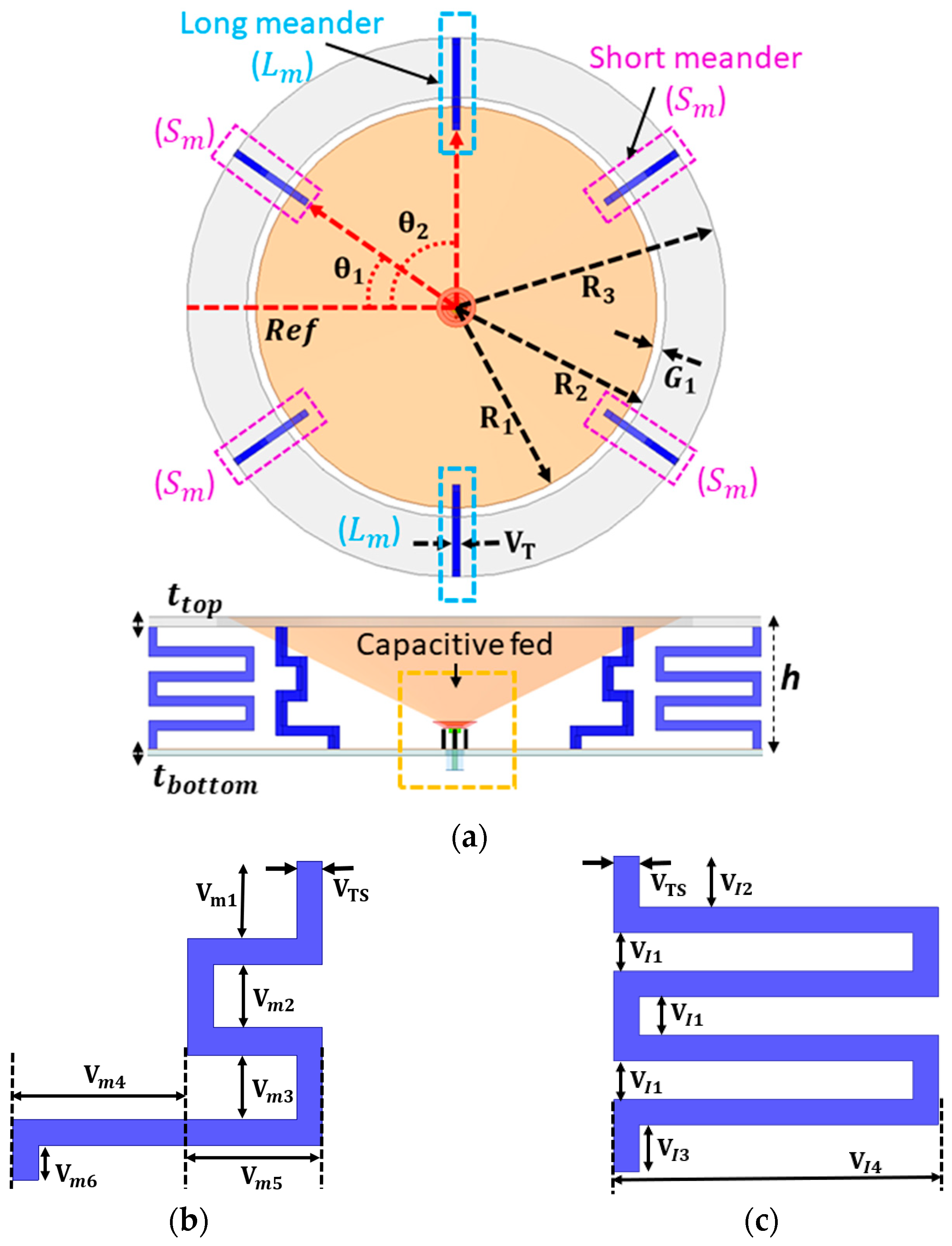

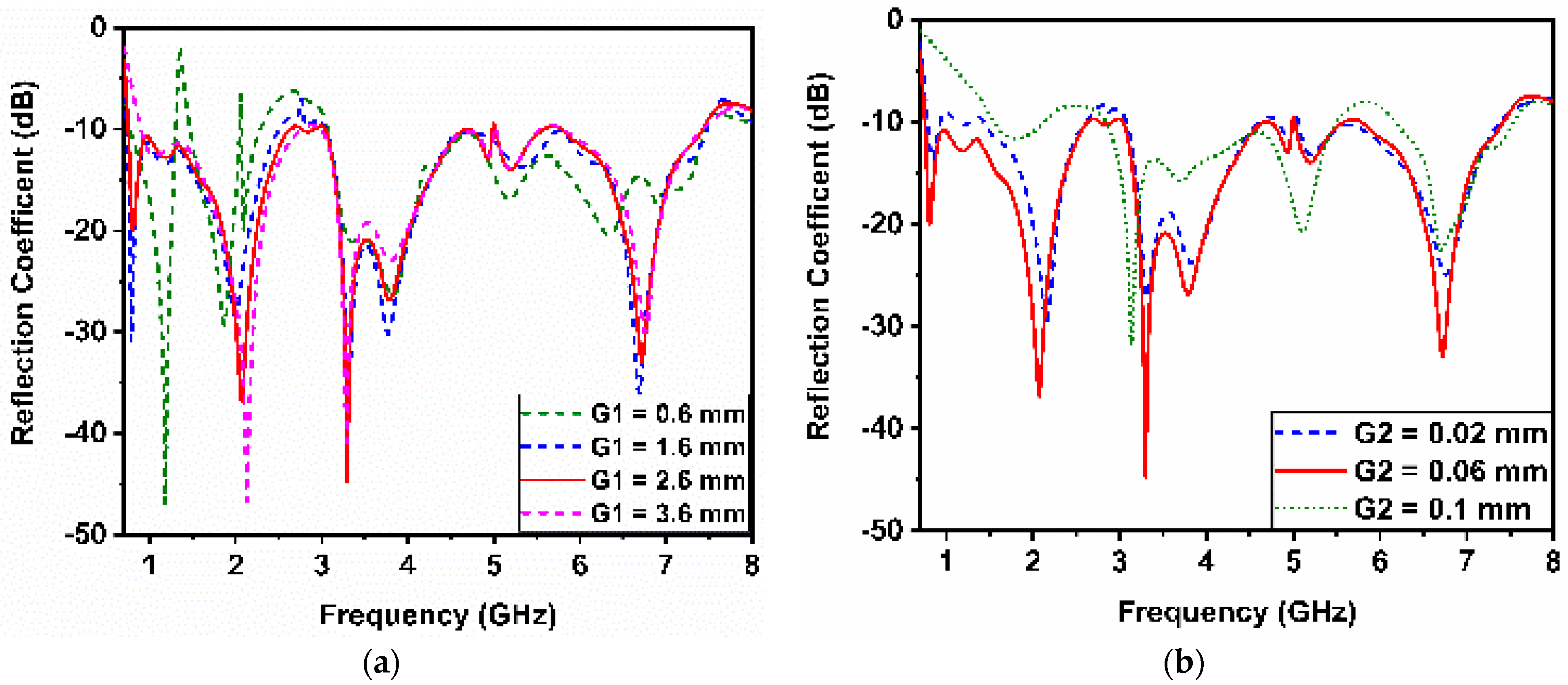
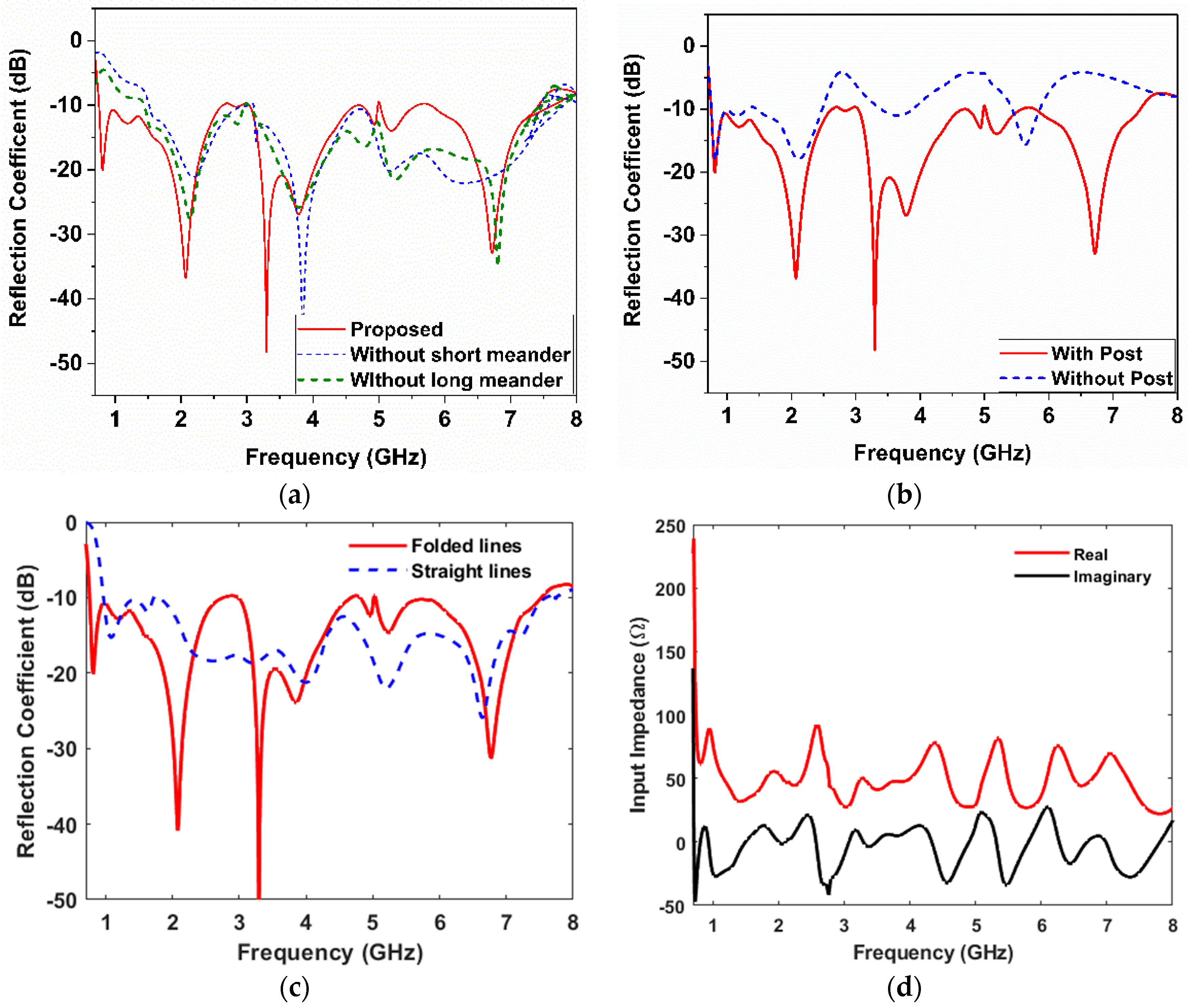
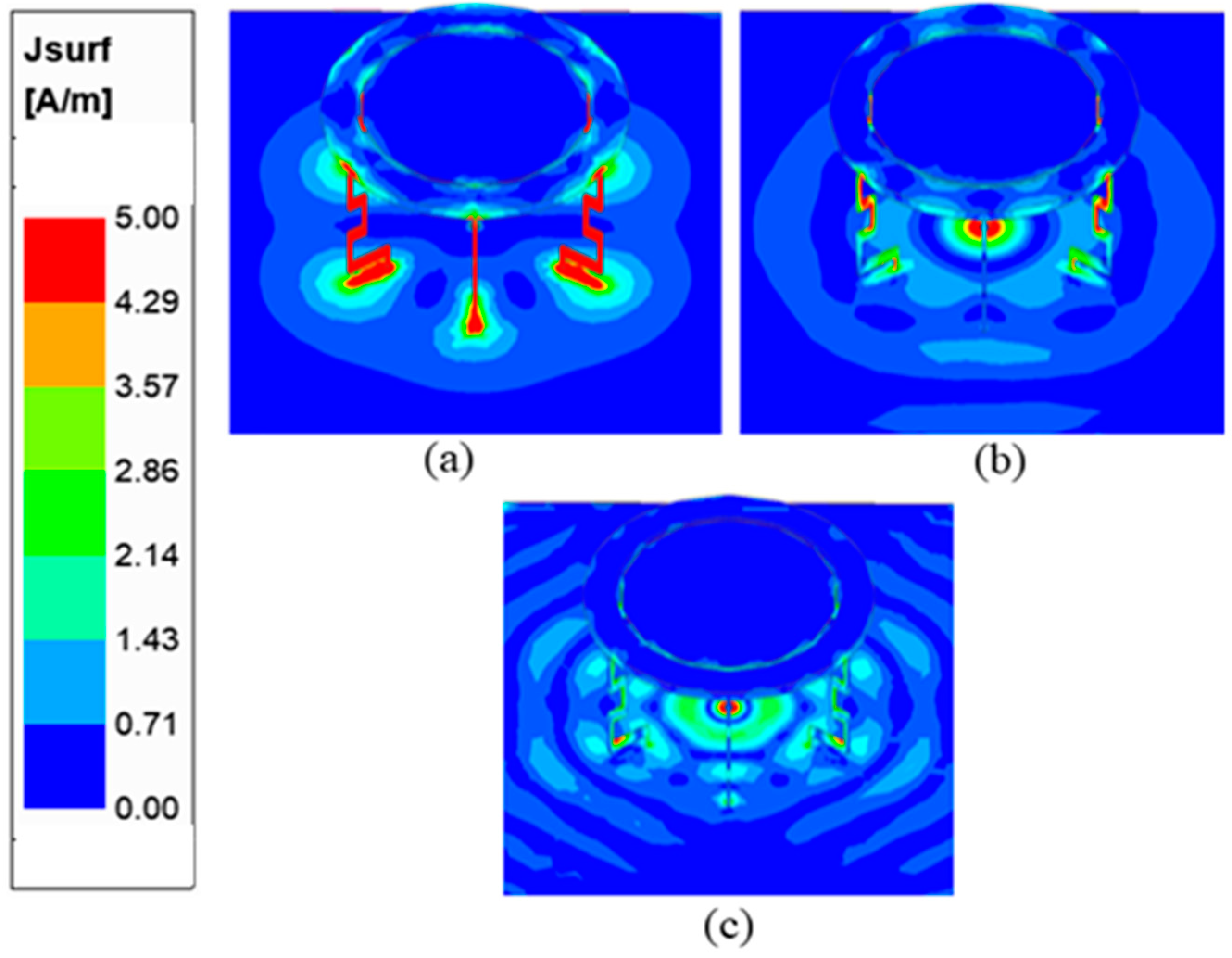

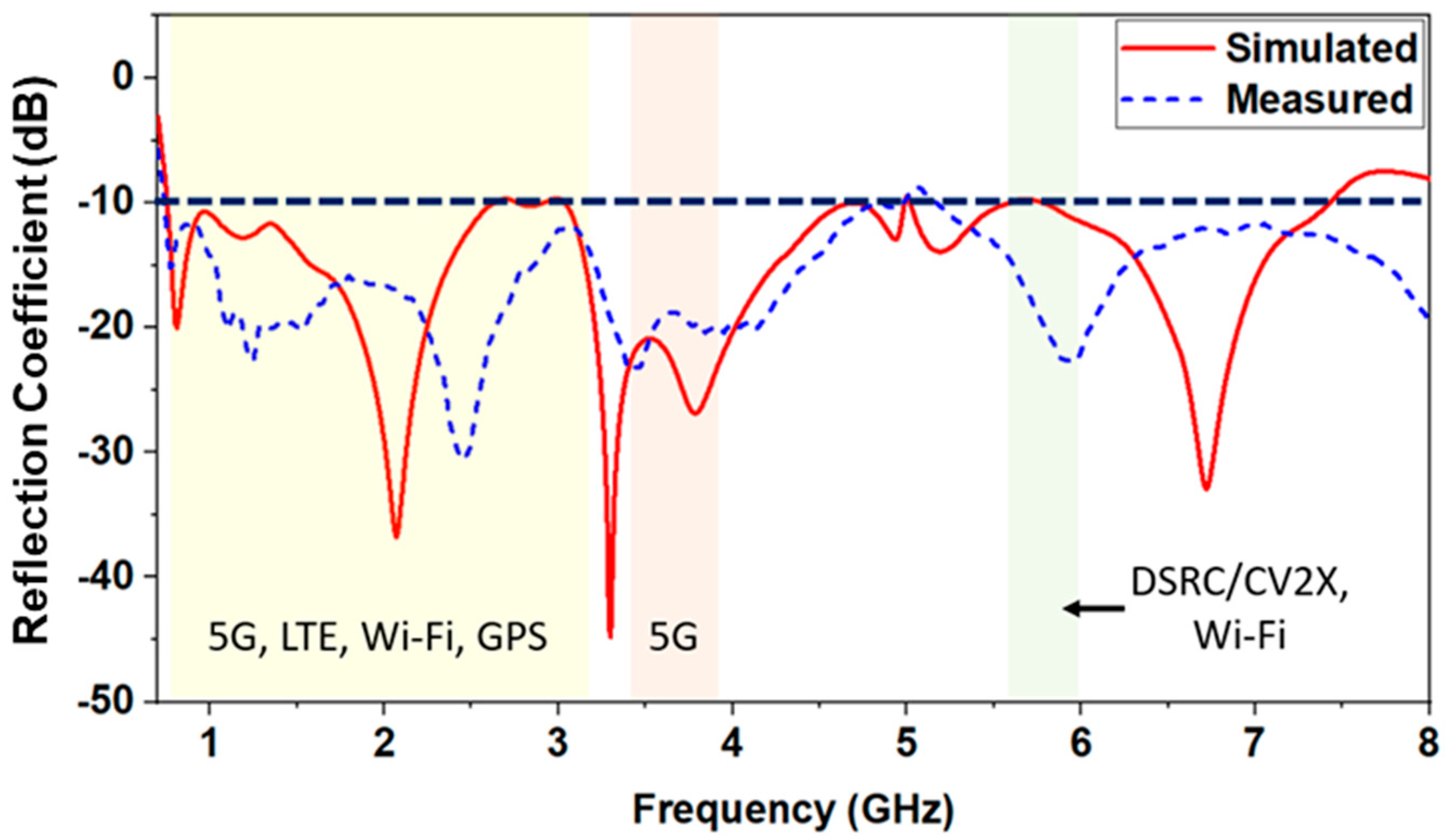
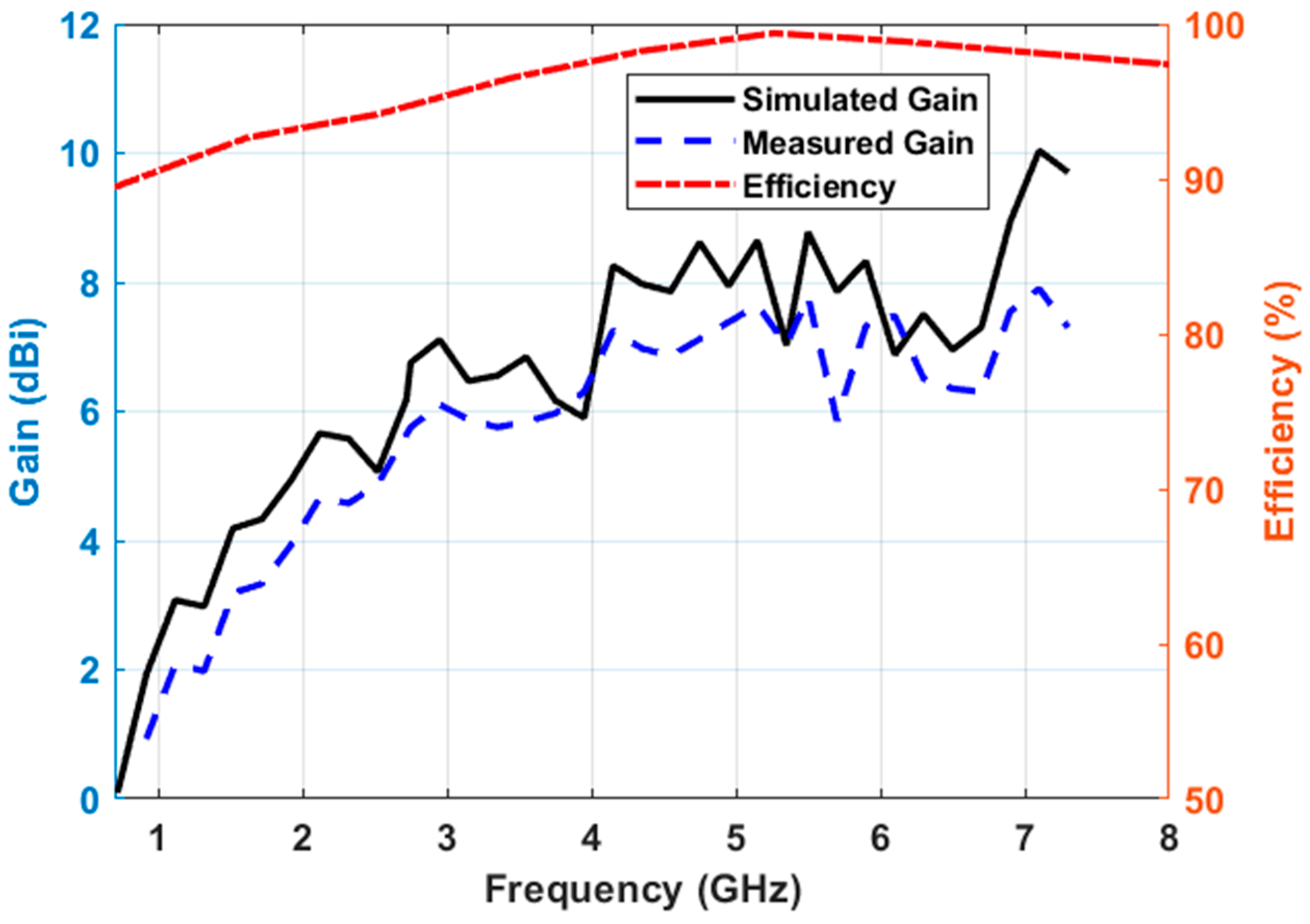
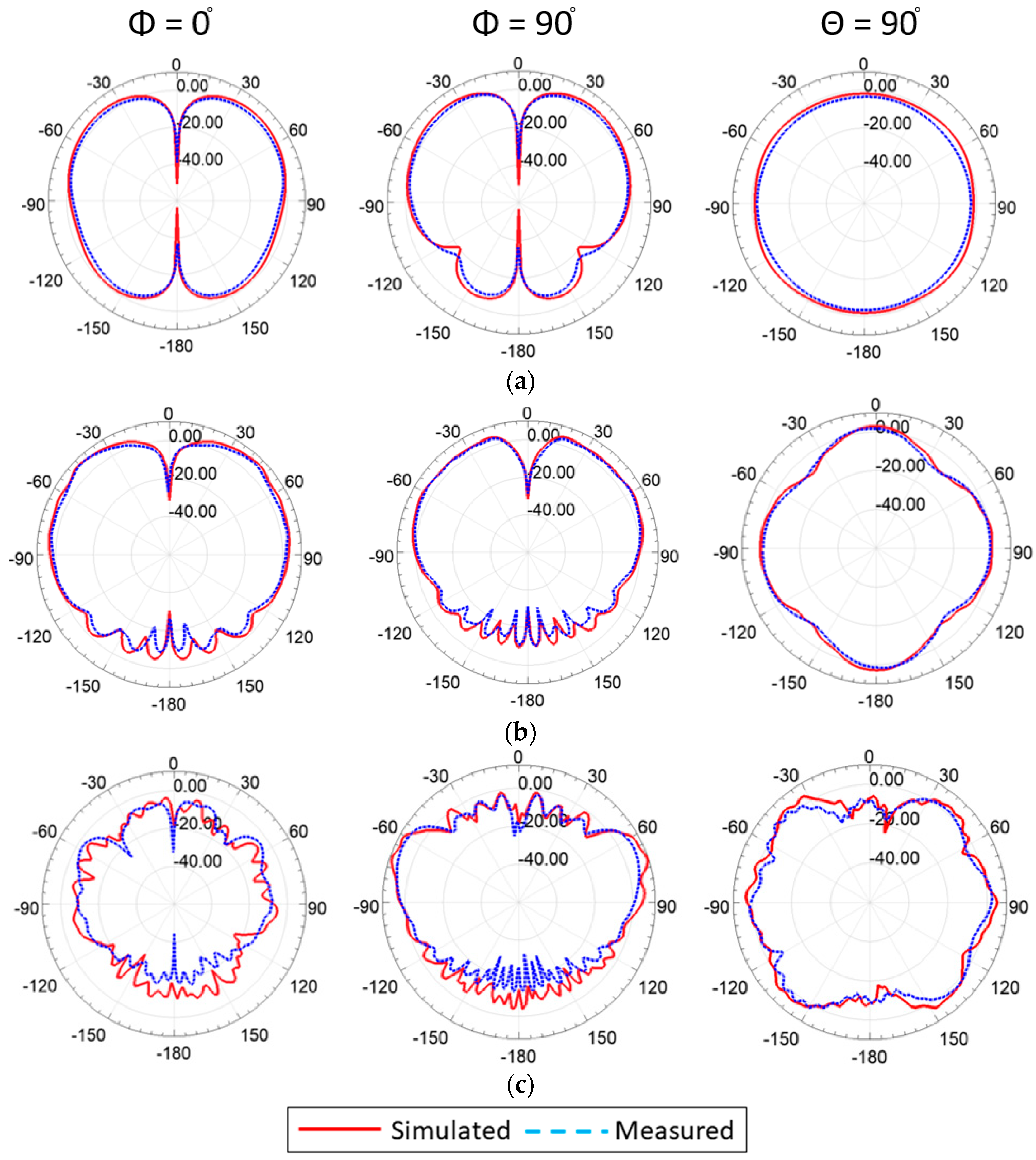
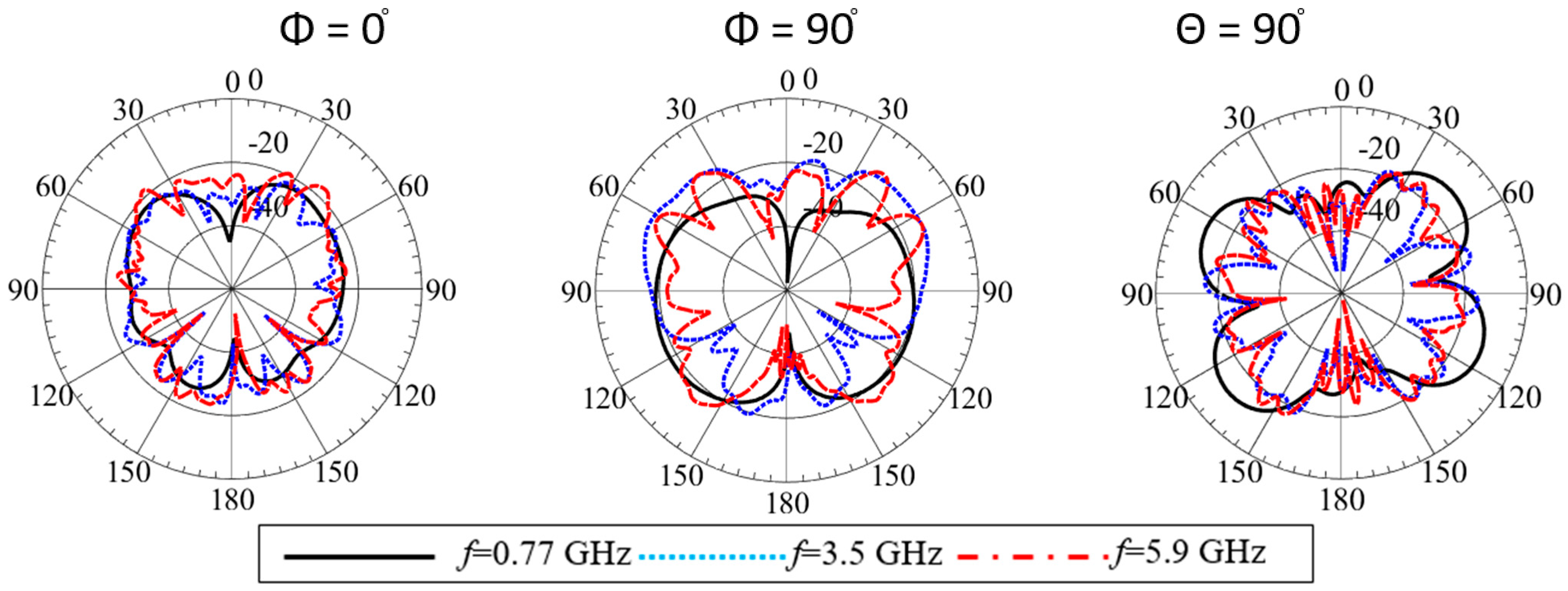
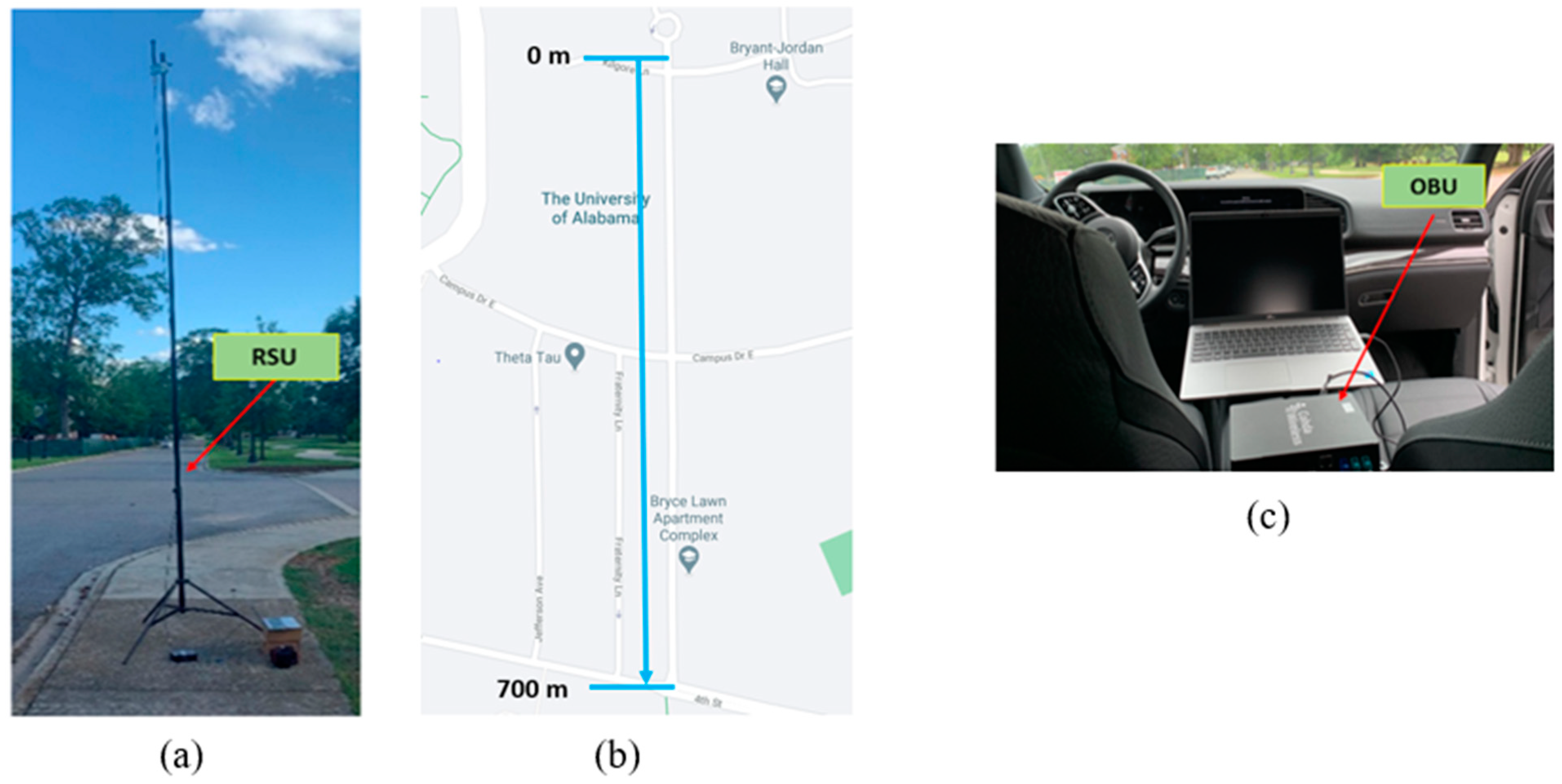


| R1 | R2 | R3 | 1 | 2 | VT | P1 |
| 55 | 57.6 | 74 | 35 | 90 | 2 | 1 |
| S1 | Vm1 | Vm2 | Vm3 | Vm4 | Vm5 | Vm6 |
| 1.5 | 6 | 4.8 | 4.9 | 15.6 | 8.4 | 2.7 |
| VTS | Vl1 | Vl2 | Vl3 | Vl4 | t top | h |
| 2 | 3 | 4 | 3.7 | 25.4 | 2 | 26.69 |
| RC1 | RC2 | Pp1 | ||||
| 5.4 | 2.01 | 2.2 |
| Ref | Frequency (GHz) | BW% | Gain (dBi) | |
|---|---|---|---|---|
| [6] | 1.6–11.7 | 151 | 3–8 | 0.363 × 0.363 × 0.057 |
| [8] | 2.4–7.98 | 107 | NA | 0.468 × 0.468 × NA |
| [9] | 0.8–2.4 | 100 | 1.7–9 | 0.364 × 0.364 × 0.068 |
| [18] | 0.8–2.3 | 97 | 2–6 | 0.208 × 0.208 × 0.068 |
| [19] | 3.06–12 | 119 | NA | 0.204 × 0.204 × 0.087 |
| [21] | 1.17–30 | 185 | 2.55 @ 2 GHz | 0.363 × 0.363 × 0.122 |
| [23] | 0.8–2.5 | 103 | 2–8 | 0.267 × 0.267 × 0.064 |
| [24] | 6.2–18 | 98 | 3.2–10.1 | 0.95 × 1.07 × 0.072 |
| [26] | 1.43–39.05 | 185.8 | 5.8–10.7 | 0.95 × 0.95 × 0.143 |
| [34] | 1.15–1.6 | 32 | 5–8.1 | 0.575 × 0.575 × 0.115 |
| [35] | 1.559–1.610, 2.32–2.345 | N/A | 2.24–5.52 | 0.187 × 0.187 × 0.031 |
| [This work] | 0.75–7.6 | 164 | 2–10 | 0.37 × 0.37 × 0.067 |
Disclaimer/Publisher’s Note: The statements, opinions and data contained in all publications are solely those of the individual author(s) and contributor(s) and not of MDPI and/or the editor(s). MDPI and/or the editor(s) disclaim responsibility for any injury to people or property resulting from any ideas, methods, instructions or products referred to in the content. |
© 2023 by the authors. Licensee MDPI, Basel, Switzerland. This article is an open access article distributed under the terms and conditions of the Creative Commons Attribution (CC BY) license (https://creativecommons.org/licenses/by/4.0/).
Share and Cite
Lee, M.W.; Abushakra, F.; Choffin, Z.; Kim, S.; Lee, H.-J.; Jeong, N. A Compact Ultra-Wideband Monocone Antenna with Folded Shorting Wires for Vehicle-to-Everything (V2X) Applications. Sensors 2023, 23, 6086. https://doi.org/10.3390/s23136086
Lee MW, Abushakra F, Choffin Z, Kim S, Lee H-J, Jeong N. A Compact Ultra-Wideband Monocone Antenna with Folded Shorting Wires for Vehicle-to-Everything (V2X) Applications. Sensors. 2023; 23(13):6086. https://doi.org/10.3390/s23136086
Chicago/Turabian StyleLee, Martin Wooseop, Feras Abushakra, Zachary Choffin, Sangkil Kim, Hee-Jo Lee, and Nathan Jeong. 2023. "A Compact Ultra-Wideband Monocone Antenna with Folded Shorting Wires for Vehicle-to-Everything (V2X) Applications" Sensors 23, no. 13: 6086. https://doi.org/10.3390/s23136086
APA StyleLee, M. W., Abushakra, F., Choffin, Z., Kim, S., Lee, H.-J., & Jeong, N. (2023). A Compact Ultra-Wideband Monocone Antenna with Folded Shorting Wires for Vehicle-to-Everything (V2X) Applications. Sensors, 23(13), 6086. https://doi.org/10.3390/s23136086










